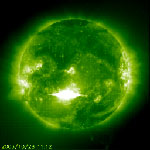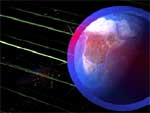NASA's SORCE Satellite Celebrates One Year of Operatios
Caption for Item 1: RECENT OBSERVATIONS
SORCE recorded the most comprehensive dataset ever of the complex changes in the Sun - namely total solar brightness decrease by a whopping 3 tenths of one percent. The XPS instrument records solar soft x-ray (XUV) irradiance from the Sun's outer atmosphere, the corona. That energy heats and ionizes Earth's atmosphere. Credit: NASA
Item 1: Click on image to view movie.
Having marked its first anniversary on-orbit, NASA's Solar Radiation and Climate Experiment (SORCE) satellite has hit its stride. In concert with other satellites, SORCE's observations of the Sun's brightness are helping researchers better understand climate change, climate prediction, atmospheric ozone, the sunburn causing ultraviolet-B radiation and space weather.
In the fall of 2003, SORCE was fortunate to see and measure the exceptionally high levels of the Sun's activities. In late October and November the Sun sent solar flares and coronal mass ejections hurtling Earthward, disrupting satellites and other transmissions, triggering an intense geomagnetic storm, enabling the northern lights to be seen as far south as Arkansas, Texas and Oklahoma.
Caption for Item 2: RECORD-BREAKING FLARES FROM SUN
On Oct. 28 spacecraft tracked an unusually fast-moving X-17.2 sized flare - the second largest ever observed by SOHO. The spot blasted off two more flares including a record-setting X-28 on Nov. 4. Credit: NASA / ESA
Item 2: Click on image to view movie.
The spacecraft recorded unusual data from the massive record-setting solar flares in late October/November 2003. The most powerful flares ever observed in X-rays, including the absolute largest, were accompanied by large sunspots which produced a complex change in energy output; SORCE saw total solar brightness decrease by 3 tenths of one percent. To put that into perspective, the last time Earth experienced that sort of decrease, drastic climate change occurred and Earth experienced the "Little Ice Age." Of course, that 3 tenths of one percent lasted 50 years while this decrease lasted a week.
Caption for Item 3: TRACKING THE SOLAR SPECTRUM
SORCE measures the wavelengths of the energy reaching the Earth from the Sun. Credit: NASA
Item 3: Click on image to view animation.
Having accurate knowledge of the Sun's brightness variations on all time scales from flares to centuries - at all wavelengths that are heating the Earth's atmosphere, land and oceans is an essential step to understand, model and predict impacts of the Sun on Earth. Two of the SORCE instruments the Total Irradiance Monitor (TIM) and the Spectral Irradiance Monitor (SIM) instruments - will ultimately be part of the operational measurements made by the National Polar-orbiting Operational Environmental Satellite System (NPOESS) satellites beginning in 2013. Solar irradiance has been monitored since the 1970s in order to create a long-term record for study be researchers.
"The spacecraft and instruments have all been performing beautifully since launch, and the new solar data exceed all of our expectationsî said Gary Rottman, SORCE Principal Investigator at University of Colorado's Laboratory for Atmospheric and Space Physics (LASP) in Boulder, Colorado. ěThe Sun also cooperated by putting on an unusual display of intense activity in late October which provided some of the largest sunspots ever recorded and produced major flares surpassing all previous observations. These unexpected phenomena will help us better understand how the Sun functions and how it influences the terrestrial environment."
Caption for Items 4 - 5: DOWN TO EARTH: SOLAR RAYS
Only about 70% of the solar energy that reaches Earth is absorbed, while the other 30% is reflected back into space by atmosphere and aerosols, ocean/land and clouds. Credit: NASA
Items 4 - 5: Click on images to view animations.
"For the very first time we have observations capable of characterizing simultaneously the variations in the total solar irradiance and in the visible and near infrared part of the solar electromagnetic spectrum that provides the primary energy to the Earth's surface," said Dr. Judith Lean, Research Physicist at the Naval Research Laboratories and a member of the National Academy of Sciences. "Simple models exist of solar spectrum variability, that general circulation models use to simulate climate response to solar forcing. SORCE data already indicate that the models need to be revised at infrared wavelengths; they promise unprecedented new understanding of the mechanisms of solar spectral irradiance variability and their possible climatic impacts."
Caption for Item 6: A SLOW TIME - THE SOLAR CYCLE
We're edging toward a tamer period of the Sun's 11-year cycle, with 'solar max' having occurred between 1999 and 2001. Credit: NASA
Item 6: Click on image to view animation.
This mission is a joint partnership between NASA and LASP. As a principal investigator led mission, NASA provided management oversight and engineering support. Scientists and engineers at the University of Colorado designed, built, calibrated, and tested the four science instruments on the satellite. The Mission Operations Center and the Science Operations Center are both located at the University.
Caption for Item 7: SORCE SPACECRAFT
SORCE maintains a 24-year legacy of solar output monitoring that should help explain and predict the effect of the Sun on the Earth's atmosphere and climate. Credit: NASA / LASP
Item 7: Click on image to enlarge.
For more information contact:
David E. Steitz
Headquarters, Washington
(Phone: 202/358-1730)
Lynn Chandler
Goddard Space Flight Center, Greenbelt, Md.
(Phone: 301/286-2806)
Rachel Weintraub
Goddard Space Flight Center,
Greenbelt, Md.
(Phone: 301/286-0918)
More Information:






